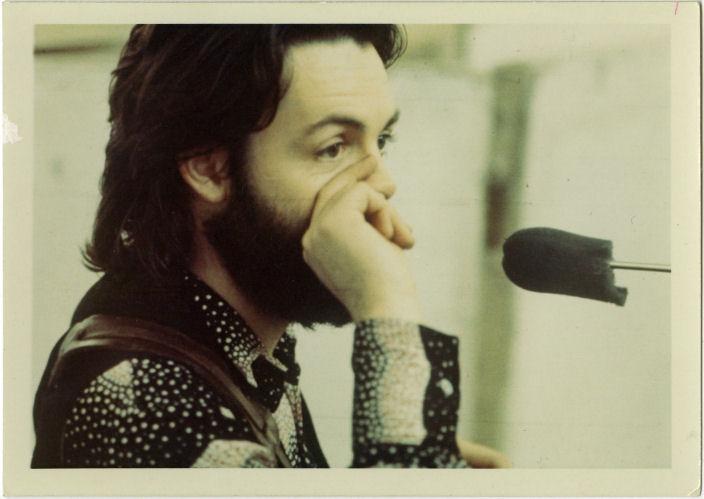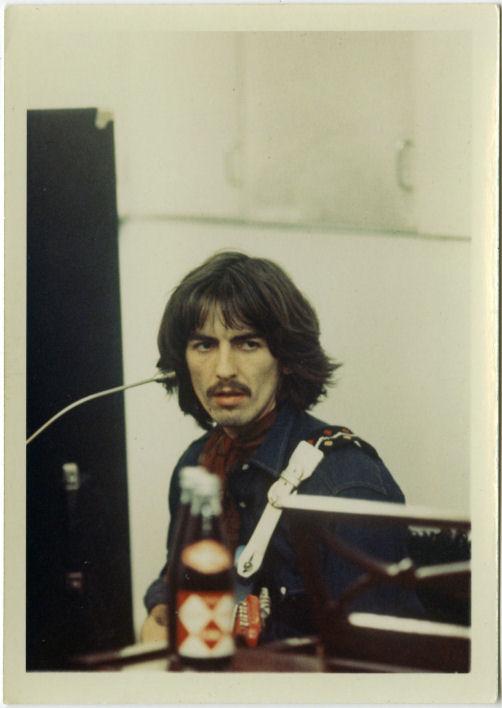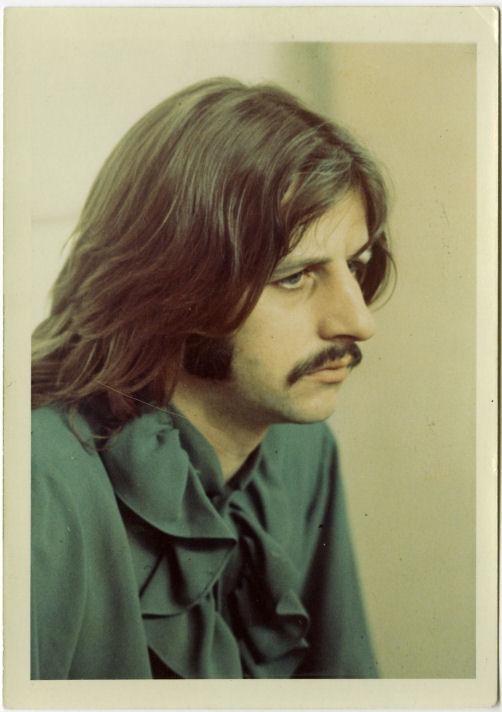Let It Be is the twelfth and final studio album, It was released on 8 May 1970, almost a month after the group’s break-up, in tandem with the motion picture of the same name. Like most of the band’s previous releases, the album topped record charts in many countries, including both the US and the UK. However, the critical response was generally unfavourable, and Let It Be came to be regarded as one of the most controversial rock albums ever.
 Rehearsals began at Twickenham Film Studios in January 1969 as part of a planned documentary showing the Beatles’ return to live performance. Paul McCartney conceived the project as an attempt to reinvigorate the band by returning to simpler rock and roll configurations.The filmed rehearsals were marked by ill-feeling, leading to George Harrison’s temporary departure from the group. As a condition of his return, the members reconvened at their own Apple Studio with guest keyboardist Billy Preston. The project then yielded a single public concert, held impromptu on the studio’s rooftop on 30 January, from which three of the album’s tracks were drawn.
Rehearsals began at Twickenham Film Studios in January 1969 as part of a planned documentary showing the Beatles’ return to live performance. Paul McCartney conceived the project as an attempt to reinvigorate the band by returning to simpler rock and roll configurations.The filmed rehearsals were marked by ill-feeling, leading to George Harrison’s temporary departure from the group. As a condition of his return, the members reconvened at their own Apple Studio with guest keyboardist Billy Preston. The project then yielded a single public concert, held impromptu on the studio’s rooftop on 30 January, from which three of the album’s tracks were drawn.
 In April 1969, the Beatles issued the single “Get Back”, after which engineer Glyn Johns proposed rejected mixes of the album, then titled Get Back, that were widely bootlegged before release. From then, the project lay in limbo as they moved onto the recording of Abbey Road, released that September. By then, John Lennon had departed the group. In January 1970, the remaining Beatles finished the album with the completion of “Let It Be” and “I Me Mine”. The former was issued as a single in April 1970, and like all the album’s recording to this point, was produced by George Martin.
In April 1969, the Beatles issued the single “Get Back”, after which engineer Glyn Johns proposed rejected mixes of the album, then titled Get Back, that were widely bootlegged before release. From then, the project lay in limbo as they moved onto the recording of Abbey Road, released that September. By then, John Lennon had departed the group. In January 1970, the remaining Beatles finished the album with the completion of “Let It Be” and “I Me Mine”. The former was issued as a single in April 1970, and like all the album’s recording to this point, was produced by George Martin.
Get Back was ultimately assembled under the title of Let It Be by the American producer Phil Spector in early 1970. He omitted “Don’t Let Me Down”, the B-side of the “Get Back” single, and instead included a 1968 take of “Across the Universe”. Spector also included excerpts of studio chatter and applied original orchestral and choir overdubs to four tracks. The additions offended McCartney, particularly in the case of “The Long and Winding Road”. In 2003, he spearheaded Let It Be… Naked, an alternative mix of Let It Be that removes Spector’s embellishments.
 By late 1968, more than two years after the Beatles gave up touring, Paul McCartney was eager for the group to perform live again. The other three Beatles were less enthusiastic about McCartney’s proposals as they had just completed five months’ work on the band’s self-titled double album (also known as the “White Album”), and the sessions had seen a number of serious arguments and strained relations among the group. George Harrison in particular was opposed to the idea of touring, having taken the strongest dislike of any in the group to the gruelling tours of the Beatlemania era.
By late 1968, more than two years after the Beatles gave up touring, Paul McCartney was eager for the group to perform live again. The other three Beatles were less enthusiastic about McCartney’s proposals as they had just completed five months’ work on the band’s self-titled double album (also known as the “White Album”), and the sessions had seen a number of serious arguments and strained relations among the group. George Harrison in particular was opposed to the idea of touring, having taken the strongest dislike of any in the group to the gruelling tours of the Beatlemania era.
The Twickenham rehearsals quickly disintegrated into what was characterised as a “hostile lethargy”.According to journalist Michael Housego of the Daily Sketch, disagreements between Harrison and Lennon descended into violence with them allegedly throwing punches at each other. Harrison denied this in a 16 January interview for the Daily Express, saying: “There was no punch-up. We just fell out.” After lunch, Harrison announced that he was “leaving the band now” and told the others “see you round the clubs”.
A week later the band agreed to Harrison’s terms for returning to the group, which included abandoning the cold and cavernous soundstage at Twickenham. Sessions resumed on 21 January when the Beatles moved to Apple Studio, in the basement of their Apple Corps building at 3 Savile Row, central London. Multi-track recording began on that date and continued until 31 January.
Days after the sessions at Apple had ended, Glyn Johns put together a rough mix acetate of several songs, for the band to listen to. A tape copy of this acetate made its way to America, where it was played on radio stations in Buffalo and Boston over September 1969. In March 1969, Lennon and McCartney had called Johns to Abbey Road and offered him free rein to compile an album from the Get Back recordings.
Johns booked time at Olympic Studios between 10 March and 28 May to mix the album and completed the final banded master tape on 28 May. Only one track, “One After 909”, was taken from the rooftop concert, with “I’ve Got a Feeling” and “Dig a Pony” (then called “All I Want Is You”) being studio recordings instead. Johns also favoured earlier, rougher versions of “Two of Us” and “The Long and Winding Road” over the more polished performances from the final, 31 January session (which were eventually chosen for the Let It Be album). It also included a jam called “Rocker”, a brief rendition of the Drifters’ “Save the Last Dance for Me”, Lennon’s “Don’t Let Me Down” and a five-minute version of “Dig It”.
The cover of the proposed album featured a photograph of the Beatles by Angus McBean taken in the interior stairwell at EMI’s Manchester Square headquarters. The photo was intended as an update of the group’s Please Please Me cover image from 1963 and was particularly favoured by Lennon. The text design and placement similarly mirrored that of the 1963 LP sleeve.
 On 15 December, the Beatles again approached Johns to compile an album, but this time with the instruction that the songs must match those included in the as yet unreleased Get Back film. Between 15 December 1969 and 8 January 1970, new mixes were prepared. Glyn Johns’ new mix omitted “Teddy Boy” as the song did not appear in the film. It added “Across the Universe” (a remix of the 1968 studio version, as the January 1969 rehearsals had not been properly recorded) and “I Me Mine”, on which only Harrison, McCartney and Ringo Starr performed. “I Me Mine” was newly recorded on 3 January 1970, as it appeared in the film and no multi-track recording had yet been made. The Beatles once again rejected the album.
On 15 December, the Beatles again approached Johns to compile an album, but this time with the instruction that the songs must match those included in the as yet unreleased Get Back film. Between 15 December 1969 and 8 January 1970, new mixes were prepared. Glyn Johns’ new mix omitted “Teddy Boy” as the song did not appear in the film. It added “Across the Universe” (a remix of the 1968 studio version, as the January 1969 rehearsals had not been properly recorded) and “I Me Mine”, on which only Harrison, McCartney and Ringo Starr performed. “I Me Mine” was newly recorded on 3 January 1970, as it appeared in the film and no multi-track recording had yet been made. The Beatles once again rejected the album.
Several songs from the recording sessions have been released officially in versions different from those on the Let It Be album. “Get Back”/”Don’t Let Me Down” and “Let It Be” were released as singles in 1969 and 1970, respectively. Seven tracks were live performances, in accordance with the original album concept: “I’ve Got a Feeling”, “One After 909” and “Dig a Pony” from the rooftop performance, and “Two of Us”, “Dig It”, “Get Back” and “Maggie Mae” from studio sessions. Contrary to the original concept, the album versions of “For You Blue”, “I Me Mine”, “Let It Be” and “The Long and Winding Road” feature editing, splicing and/or overdubs. “Don’t Let Me Down”, also recorded live and previously released as the B-side of “Get Back”, was not included on the album.The third track on the album is an edited version of the original 1968 recording of “Across the Universe”, slowed down from D-natural to D-flat, which had only been rehearsed at Twickenham and not professionally recorded on multi-track tape during the January 1969 sessions.
McCartney was deeply dissatisfied with Spector’s treatment of some songs, particularly “The Long and Winding Road”. McCartney had conceived of the song as a simple piano ballad, but Spector dubbed in orchestral and choral accompaniment. McCartney unsuccessfully attempted to halt release of Spector’s version or at least have it altered. Despite the criticisms levelled at Spector over the years for his handling of the material, Lennon defended him in his January 21, 1971 Rolling Stone interview, saying, “…he was given the shittiest load of badly recorded shit, with a lousy feeling toward it, ever. And he made something out of it. He did a great job.”When EMI informed Martin that he would not get a production credit because Spector produced the final version, he commented “I produced the original, and what you should do is have a credit saying ‘Produced by George Martin, over-produced by Phil Spector'”.

